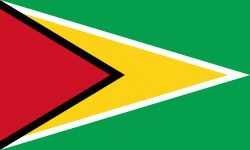Essequibo Islands-West Demerara (Essequibo Islands-West Demerara Region)
Essequibo Islands-West Demerara (Region 3) is a region of Guyana.
Split in two by the Essequibo River, Venezuela claims the territory to the west of Essequibo river as part of Delta Amacuro state, what represents Essequibo Islands. Unlike West Demerara who is located east of Essequibo river, which means is out of the dispute.
It is bordered by the Atlantic Ocean to the north, the region of Demerara-Mahaica and Demerara River to the east, the region of Upper Demerara-Berbice to the south and the region of Pomeroon-Supenaam to the west. It contains villages such as Parika, Tuschen and Uitvlugt. It contains the three hundred and sixty five islands in the Essequibo river of which three of the largest islands can be found at the mouth of the Essequibo, these are Hogg Island, Wakenaam and Leguan.
The Government of Guyana has administered three official censuses since the 1980 administrative reforms, in 1980, 1991 and 2002. In 2002, the population of Essequibo Islands-West Demerara was recorded at 103,061 people. Official census records for the population of Essequibo Islands-West Demerara are as follows:
* 2012 : 107,416
* 2002 : 103,061
* 1991 : 95,975
* 1980 : 104,750
Split in two by the Essequibo River, Venezuela claims the territory to the west of Essequibo river as part of Delta Amacuro state, what represents Essequibo Islands. Unlike West Demerara who is located east of Essequibo river, which means is out of the dispute.
It is bordered by the Atlantic Ocean to the north, the region of Demerara-Mahaica and Demerara River to the east, the region of Upper Demerara-Berbice to the south and the region of Pomeroon-Supenaam to the west. It contains villages such as Parika, Tuschen and Uitvlugt. It contains the three hundred and sixty five islands in the Essequibo river of which three of the largest islands can be found at the mouth of the Essequibo, these are Hogg Island, Wakenaam and Leguan.
The Government of Guyana has administered three official censuses since the 1980 administrative reforms, in 1980, 1991 and 2002. In 2002, the population of Essequibo Islands-West Demerara was recorded at 103,061 people. Official census records for the population of Essequibo Islands-West Demerara are as follows:
* 2012 : 107,416
* 2002 : 103,061
* 1991 : 95,975
* 1980 : 104,750
Map - Essequibo Islands-West Demerara (Essequibo Islands-West Demerara Region)
Map
Country - Guyana
 |
 |
| Flag of Guyana | |
The region known as "the Guianas" consists of the large shield landmass north of the Amazon River and east of the Orinoco River known as the "land of many waters". Nine indigenous tribes reside in Guyana: the Wai Wai, Macushi, Patamona, Lokono, Kalina, Wapishana, Pemon, Akawaio and Warao. Historically dominated by the Lokono and Kalina tribes, Guyana was colonised by the Dutch before coming under British control in the late 18th century. It was governed as British Guiana, with a mostly plantation-style economy until the 1950s. It gained independence in 1966, and officially became a republic within the Commonwealth of Nations in 1970. The legacy of British rule is reflected in the country's political administration and diverse population, which includes Indian, African, Indigenous, Chinese, Portuguese, other European, and various multiracial groups. In 2017, 41% of the population of Guyana lived below the poverty line.
Currency / Language
| ISO | Currency | Symbol | Significant figures |
|---|---|---|---|
| GYD | Guyanese dollar | $ | 2 |
| ISO | Language |
|---|---|
| EN | English language |















